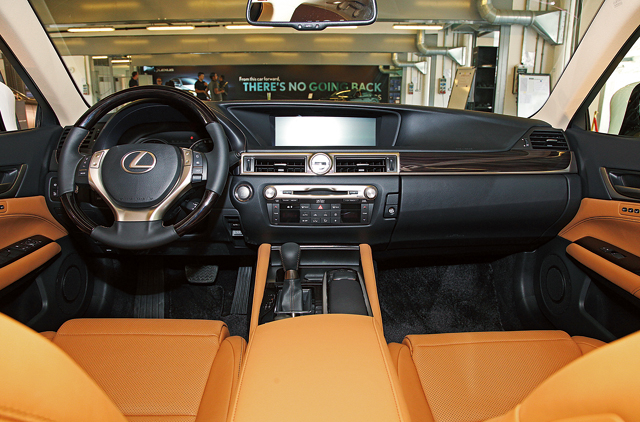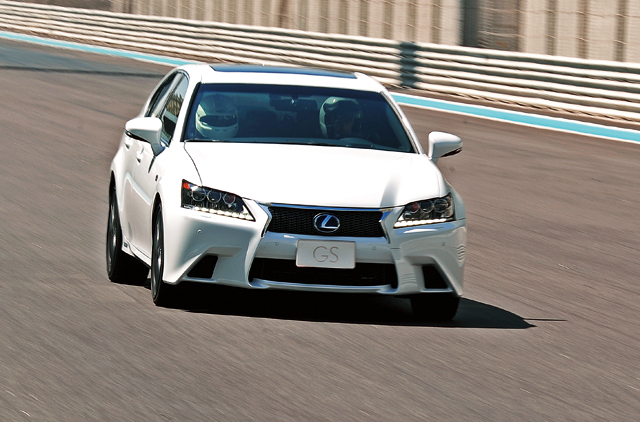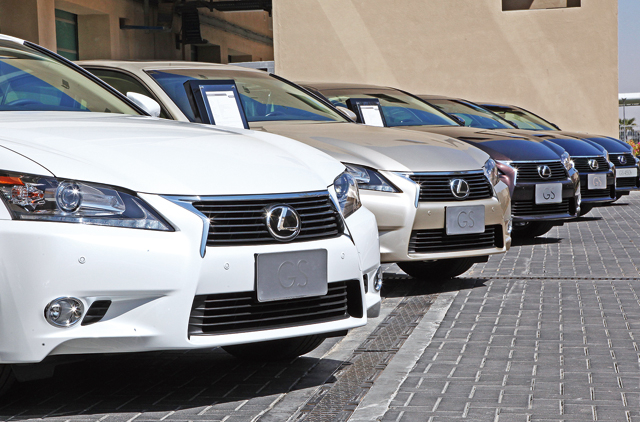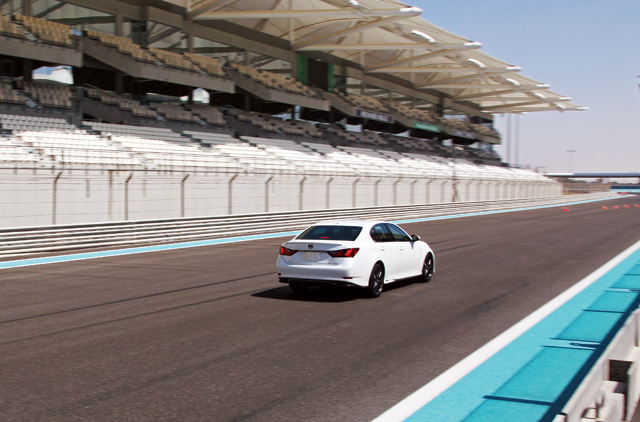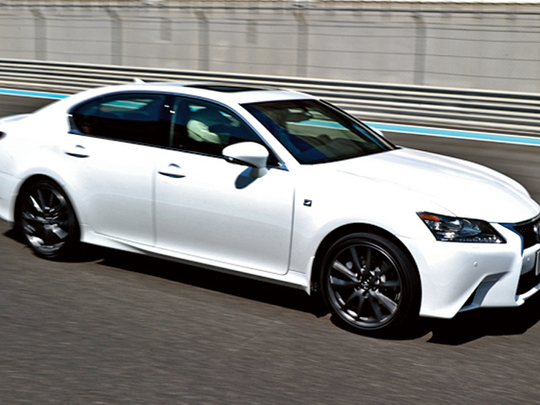
I can't tell you whether the new Lexus GS saloon is better than the BMW 5 Series, the Mercedes-Benz E-Class, or the Audi A6. But I can tell you it has four-wheel steering. That's because I drove the entire GS range at the Yas Marina circuit last week. That sounds like some thorough automotive journalism right there, but the truth is I didn't get nearly enough wheel-time to suss out any of the cars.
I did figure out that four-wheel steering though, and here's how it works: the rear wheels steer.
Thanks for reading, see you again next week…
Fine, so there is a bit more to the GS than just rear wheels that tilt by up to two degrees. For example there are its looks, as well as the sheer weight resting on its hunched shoulders. Figuratively speaking.
Over the last two decades, Lexus has managed to shift 22,000 GS models in the Middle East. If you take the company's global annual sales, reaching almost half a million today, that little number of 22,000 might pale in comparison, but remember that it's just one model line we're talking about, in just one world region.
The GS is more than just 22,000 sales. Tadashi Asazuma, the Middle East general manager of sales and marketing at Lexus, readily admits to me over some prime Australian steak that, while the LS might be the company's flagship, the new GS is its core.
Core is a word that I keep hearing a lot, especially from Yoshihiko Kanamori, chief engineer at Lexus and the man responsible for the new GS. (It stands for Grand Touring Sedan. Should somebody tell them that makes it a GTS?)
His latest creation took him five full years of hard graft, mainly because the GS is for once truly new. The previous however-many generations [Ed: there were three] were all nondescript appliances, differentiated from even more nondescript Toyota products by just one aspect: rear-wheel drive.
The new GS rides on a freshly developed platform, with a 2,850mm wheelbase, and a 2in-wider track than before. Kanamori was also adamant that the suspension needed a thorough revamp, plus he decked it all out in aluminium to save unsprung weight and aid comfort and agility. The front end is now a double wishbone set-up while the rear is a typical multi-link, and there are adaptive dampers in all four corners.
The whole thing is also stiffer than ever, with more spot welds and laser welds in places where they count most.
There are currently two choices, the base GS 250 and the GS 350, which heads the table. At least up until the flagship GS 450h comes to the market — probably as early as next month — whirring up 338 total horsepower with a combined effort from a 3.5-litre V6 and a compact electric motor powered by nickel hydride batteries stored in the back. The hybrid model comes with the burden of at least 100 extra kilograms, but it's still quickest from 0-100kph with a time of 5.6 seconds. Yet, this being a market averse to hybrids, Lexus fully expects the GS 350 to be the man of the house and provide for the family.
With a 3.5-litre V6 good for 306bhp and 378Nm of torque, it provides just fine. Launches are swift, but not abrupt, thanks to the big Lexus propensity to squat and dig in before wafting off the line, rather than clawing away like a stiff BMW or Audi would. That's also nice for ride comfort around the admittedly pristinely surfaced Yas Marina northern loop, but I did manage to notice the complete absence of wind noise around the mirrors and A-pillars as well.
Kanamori can go ahead and give everyone on the NVH team a nice bonus.
The core — there's that word again — engine might sound similar to the predecessor on paper, but Lexus ensured enough revisions to earn it the ‘new' tag. It gets better fuel economy, and more responsive performance, plus direct injection this time. Lexus worked hard on the intake and exhaust sound characteristics, and even implemented something called "sound production" to act above 2,500rpm: the "magic sound", as Kanamori likes to refer to it. And the GS 350 actually sounds nice, like when you're a kid and you accidentally wake your father up from a nap with a cricket ball. All is peaceful and quiet in the world, and then suddenly 2,500rpm, and you get a smack on the head.
As for the GS 250 and its 2.5-litre V6, it's OK, I guess. I don't know. I spent a minute-and-a-half in it. It makes 206 horsepower and costs Dh195K. Moving on…
Kanamori wants to talk about core again. I make an excuse about my ones and twos but Kanamori is patient, and he waits to tell me all about the styling. I don't need any convincing that the GS 350 looks fantastic — especially in F Sport trim with unique bumpers, grille insert, rear spoiler and 19in staggered-width wheels. The busy front snarls angrily at you with its hectic detailing. It's all chiselled corners and jagged edges; the whole front fascia is like a topographical map of the Hajjar Mountains. Around the back, the styling cues are slightly more subdued, but the middle part is completely featureless without any character lines. It's just some body panels. I still think that for a conservative Lexus family saloon, a volume seller, it's a great piece of stand-out styling.
The interior is on the money too, with loads of variations in trim, leather and colour, but the red matched with brushed-aluminium inlays is the deal-clincher for me. The steering wheel feels perfect in your hands, and the wide centre console minimises fuss. The centre piece is on the tunnel console; Lexus's new computer mouse thingy controls everything you see on the gigantic 12.3in screen.
All good and well, but how does the GS 350 drive? Actually, they all drive very Lexus-like; in other words not very sporty. Road-holding is great, thanks to the rear steering wheels — inwards at speed, outwards at low speeds for sharper control and quicker steering — but the whole experience is sort of detached. Alien even. Every habituated nerve in your body wants to correct the steering that split-second before a looming tail-slide, but it never comes in the Lexus. You dial in a dab of oppo and you just end up steering in the other direction, killing traffic cones. Once you become familiarised with the unfamiliar four-wheel steering and the car's intrusive electronics (even in Sport S+ mode), you learn to just point the new GS at the desired line of travel and let the car tread its own path there.
So, like I said. I can't tell you whether the new Lexus GS saloon is better than the BMW 5 Series, the Mercedes-Benz E-Class, or the Audi A6, but I can tell you it has four-wheel steering.
Specs
Model GS 350
Engine 3.5-litre V6
Transmission Six-speed auto, RWD
Max power 306bhp @ 6,400rpm
Max torque 378Nm @ 4,800rpm
Top speed NA
0-100kph 5.7sec
Price Dh235,000
Plus Great looks, smooth ride quality, well priced
Minus Not sporty


